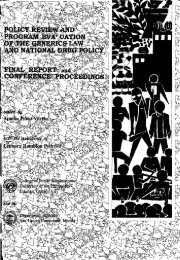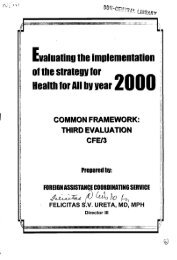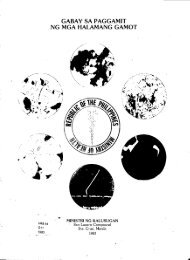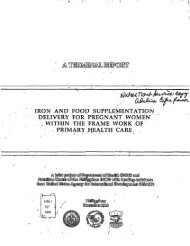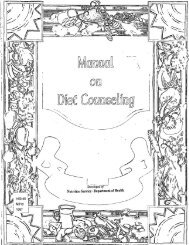ON FOOD fORTI - DOH Central Library - Department of Health
ON FOOD fORTI - DOH Central Library - Department of Health
ON FOOD fORTI - DOH Central Library - Department of Health
Create successful ePaper yourself
Turn your PDF publications into a flip-book with our unique Google optimized e-Paper software.
FVRice: WHAT IS IT?<br />
FVRice is ordinary rice tha t has beenfortified<br />
with iron by adding a premix<br />
containing enough iron to satisfy a large<br />
requirement <strong>of</strong> individuals. FVRice-iron<br />
contains 3 mg iron per 100 g raw rice.<br />
An adult man, for example, taking the<br />
usual amount <strong>of</strong> rice he eats in a day,<br />
will satisfy more than 100% <strong>of</strong> his iron<br />
requirement. An adult woman would.<br />
satisfy about40%<strong>of</strong> her iron requirement,<br />
while a school child would satisfy 2/3<br />
<strong>of</strong> his/her requirement. These amounts<br />
should be enough considering that<br />
ordinarily, individuals are already taking<br />
in about 2/3 <strong>of</strong> their iron allowance from<br />
their diet.<br />
To make FVRice-iron, the Premix is<br />
first prepared by coating ordinary rice<br />
with a coatingsolution containingferrous<br />
sulfate, drying and then packaging the<br />
product. To use the Premix, one part<br />
<strong>of</strong> it is mixed either in the home or in<br />
the mill with 199 parts <strong>of</strong> ordinary rice<br />
to make iron enriched rice, which is then<br />
ready for cookingandconsumption. When<br />
mixed this way, one could hardly detect<br />
.the premix grains in the mixture unless<br />
the premix grains are colored, which is<br />
precisely what some retailers want to be<br />
able to distinguish enriched rice from<br />
ordinary rice.<br />
The resulting fortified rice does not<br />
changein taste or odorevenaftercooking.<br />
Ifthe premixiscolored (green), the cooked<br />
A Report on Food Fortification 25<br />
rice has a very faint greenish color, but<br />
this has beer. found notto be disagreeable..<br />
The addition <strong>of</strong> the premix <strong>of</strong> course<br />
imparts additional cost to the consumer.<br />
At current prices, it entails an additional<br />
P 0.60- P 0.75per kilo <strong>of</strong>rice - an addition<br />
<strong>of</strong> about 5% to the cost <strong>of</strong> rice.<br />
MANUFACTURE OF PREMIX<br />
Basically,the process <strong>of</strong> manufacture<br />
<strong>of</strong> the Premix is very simple. It consists<br />
<strong>of</strong> preparing the coating solution<br />
containing the required amount <strong>of</strong> iron<br />
(ferrous sulfate), pouring or spraying this<br />
on a measured amount <strong>of</strong> ordinary rice<br />
while itisbeingmixed in a rotatingtumbler<br />
or trombo( and then drying the coated<br />
rice. The resulting premix is then packed<br />
either in 5 gram polypropylene/<br />
polyethylene sachets or bags. One can<br />
do this manually over a hood, but in a<br />
larger scale manufacture, we have come<br />
out with a prototype spraying device that<br />
safeguards the safety <strong>of</strong> the workers. The<br />
prototype manufactured locally costs P<br />
85,000.<br />
Raw materials including fortificants<br />
and packaging materials are locally<br />
available (although imported).<br />
SYSTEM OF USE OF PREMIX<br />
There are two major schemes <strong>of</strong> using<br />
the premix:<br />
1) Mill enrichment where rmxmg <strong>of</strong> the<br />
premix with ordinary rice is done at<br />
the ricemill duringthe milling<strong>of</strong>palay.



